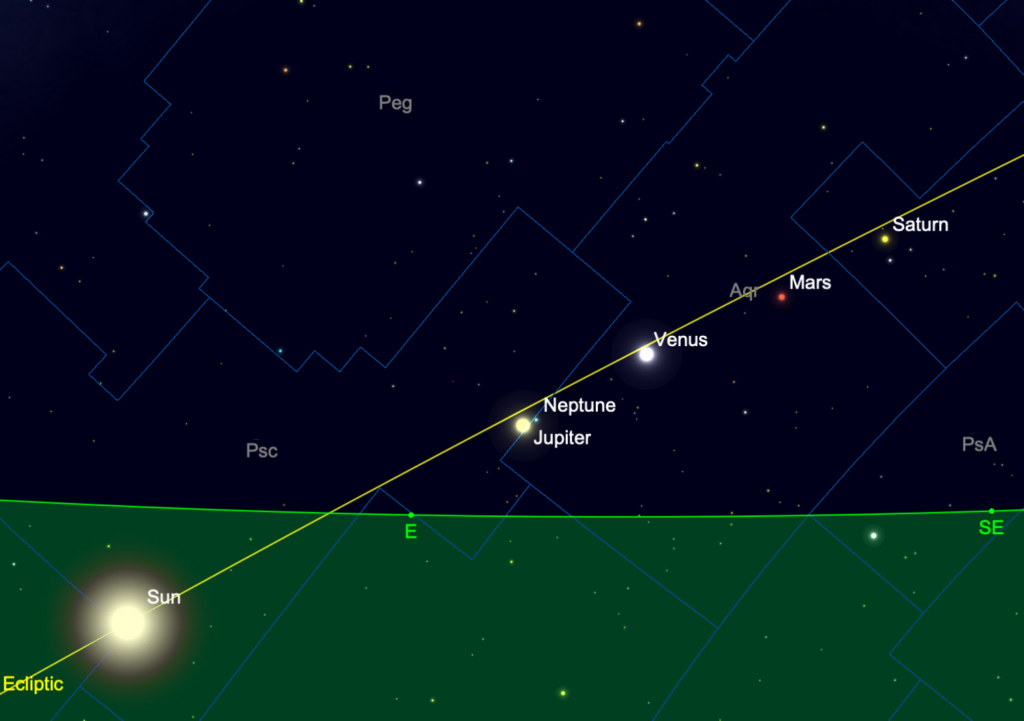Sky Report: April 18 – 24

On the 18th the planets are strung out along the yellow line, the ecliptic, or the plane of the solar system. The horizon is translucent so you can see the sun 40 minutes before sunrise. Constellation names are abbreviated while their outlines are in blue.
Graphic created with SkySafariAstronomy.com.
Planets continue to put on a great show in the morning sky, and with Daylight Time moving the sunrise to an hour later than nature intended you don’t have to get up at an unreasonable hour to see them. So here’s what’s happening this week.
Jupiter was behind the sun on March 6, but it rises 4 minutes earlier each day. By April 18 it rises 1h 20m before the sun and can be seen very low in the east in morning twilight, if you have a low horizon. If you can’t see it this week you will soon. Thus it joins Venus, Mars, and Saturn, and on the 18th they’re strung out in a line almost exactly equally spaced and 32° long. This is an interesting naked-eye treat.
Watch Jupiter approach Venus. Their relative motion will be obvious morning-by-morning. Jupiter is almost stationary against the background of stars but Venus is moving eastward as it orbits the sun. Can you estimate when they’ll be in conjunction? It’ll be a close one and it’s coming up – more on it in the next Sky Report. Already on the 24th you can see both together in all but high-power binoculars.
Mars and Saturn are much fainter than Venus and Jupiter, but they’re still brighter than nearby stars. They’re separating slowly; Mars orbits the sun much faster than Saturn, so Mars is leaving Saturn behind and it won’t be near Saturn again this year.
Neptune remains within 3° of Jupiter this week (the gap slowly increases as Jupiter moves eastward away from it), but Neptune is so faint that you won’t see it in morning twilight.
The planets are in a line. They’re always in a line, but that line is now short enough that you can clearly see it. The solar system is flat and the plane of the solar system, seen edge-on, is the ecliptic. The planets, the sun, and the moon are always on it, or near it, and they move along it. The ecliptic arches across the sky from near east to a third of the way up the southern sky to the west, the precise orientation depending on the season and the orientation of the earth’s axial tilt; at night the ecliptic is high in the winter but low in the summer.
The annual Lyrid Meteor Shower peaks on the morning of the 22nd when an observer in a dark location might see 10 or so meteors an hour. Bright moonlight will compromise the view. Don’t bother; better showers occur next month and in August.
April 22-30 is International Dark Sky Week, and recently Governor Cox proclaimed April as Utah Dark Sky Month. Citizens are rallying to the need to protect our environment from needless and wasteful light which causes a variety of harms in addition to reducing our view of the starry night sky. You can read about each by Googling “International Dark Sky Week” [https://idsw.darksky.org] and “Utah Dark Sky Month [https://governor.utah.gov/2021/04/05/utah-dark-sky-month].
Thanks to a 2021 grant from the Utah Governor’s Office of Economic Opportunity and the Kane County Office of Tourism, Stellar Vista Observatory offers portable telescopes and tripod mounted binocular kits on loan for free to all residents of Kane County. Nothing beats a quality binocular or astronomical telescope to enhance enjoyment of the night sky!
Visit https://stellarvistaobservatory.org/discover-the-night-sky/ or Kanab City Library for full details.
The Sky Report is presented as a public service by the Stellar Vista Observatory, a nonprofit organization based in Kanab, Utah, which provides opportunities for people to observe, appreciate, and comprehend our starry night sky. Additional information is at www.stellarvistaobservatory.org. Send questions and comments to John@StargazingAdventures.org.






Comments are closed.